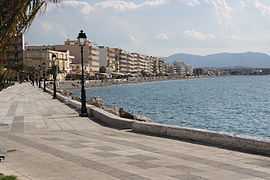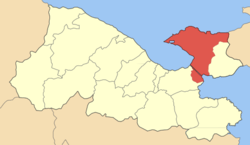Loutraki-Perachora
| Loutraki-Perachora Λουτράκι-Περαχώρα | |
|---|---|
 | |
| Location | |
 Loutraki-Perachora | |
| Coordinates | 37°59′N 22°59′E / 37.983°N 22.983°ECoordinates: 37°59′N 22°59′E / 37.983°N 22.983°E |
Location within the regional unit  | |
| Government | |
| Country: | Greece |
| Administrative region: | Peloponnese |
| Regional unit: | Corinthia |
| Municipality: | Loutraki-Agioi Theodoroi |
| Population statistics (as of 2001)[1] | |
| Municipal unit | |
| - Population: | 15,077 |
| - Area: | 196.870 km2 (76 sq mi) |
| - Density: | 77 /km2 (198 /sq mi) |
| Other | |
| Time zone: | EET/EEST (UTC+2/3) |
| Elevation (center): | 82 m (269 ft) |
| Postal code: | 203 00 |
| Telephone: | 27440 |
| Auto: | ΚΡ |
| Website | |
| www.loutraki.gr | |
Loutraki-Perachora (Greek: Λουτράκι-Περαχώρα) is a former municipality in Corinthia, Peloponnese, Greece. Since the 2011 local governmental reform it is part of the municipality Loutraki-Agioi Theodoroi, of which it is a municipal unit.[2] Loutraki, the most important settlement and the seat of the municipality, is a seaside town with a population of 11,383 inhabitants (2001 census), famous for its natural beauty, spas and mineral water springs.
Recently one of the biggest casinos in Europe has been built in Loutraki. A modern convention center has opened gates and a marina is also planned.
Loutraki sometimes is perceived as the last boundary of the Athens metropolitan area. Many Athenians live in the community permanently or seasonally.
The area is a very important tourist destination for summer and weekend visitors from the Athens metropolitan area, due to its proximity (about 80 km) and the clean and sandy beaches surrounding the town of Loutraki and other seaside settlements.
The municipality lies on both sides of the Corinth Canal, but primarily to its northeast; a small part lies on the southwest side of the canal, on the Peloponnese Peninsula. map The Corinth Canal is a partial border between the Corinthian Community and the Loutraki-Perachora Community. The Canal area, however, is the responsibility of the latter. A privately owned company operates ship traffic on the canal.
Loutraki's springs of mineral water are very well known for their exceptional qualities. A significant bottling industry has been developed due to this fact.
Perachora is a smaller village (1,256 inhabitants) NW of Loutraki at a landlocked position surrounded by mountainous landscape. Large pine forests are found there. These are the main source of the local production of natural resin. Other large towns include Kyras Vrysi (1,039 inhabitants) and Isthmia (1,030 inhabitants), the latter of which lies at the southeast entrance to the Corinth Canal. Together they form the Loutraki-Perachora Municipality. Smaller settlements like Pisia (121 inhabitants) and Schinos (49 inhabitants) are also attached to the Municipality.
The region of Loutraki-Perachora is also famous for the Heraion of Perachora (sanctuary of the goddess Hera), an archaeological site of significance located at the end of the Perachora peninsula.
Historical population
| Year | Population |
|---|---|
| 1981 | 8,543 |
| 1991 | 14,084 |
| 2001 | 15,077 |
See also
References
- ↑ De Facto Population of Greece Population and Housing Census of March 18th, 2001 (PDF 793 KB). National Statistical Service of Greece. 2003.
- ↑ Kallikratis law Greece Ministry of Interior (Greek)
 |
Gulf of Corinth |  | ||
| Gulf of Corinth | |
Megara | ||
| ||||
| | ||||
| Corinth | Saronic Gulf | Agioi Theodoroi |
| ||||||||